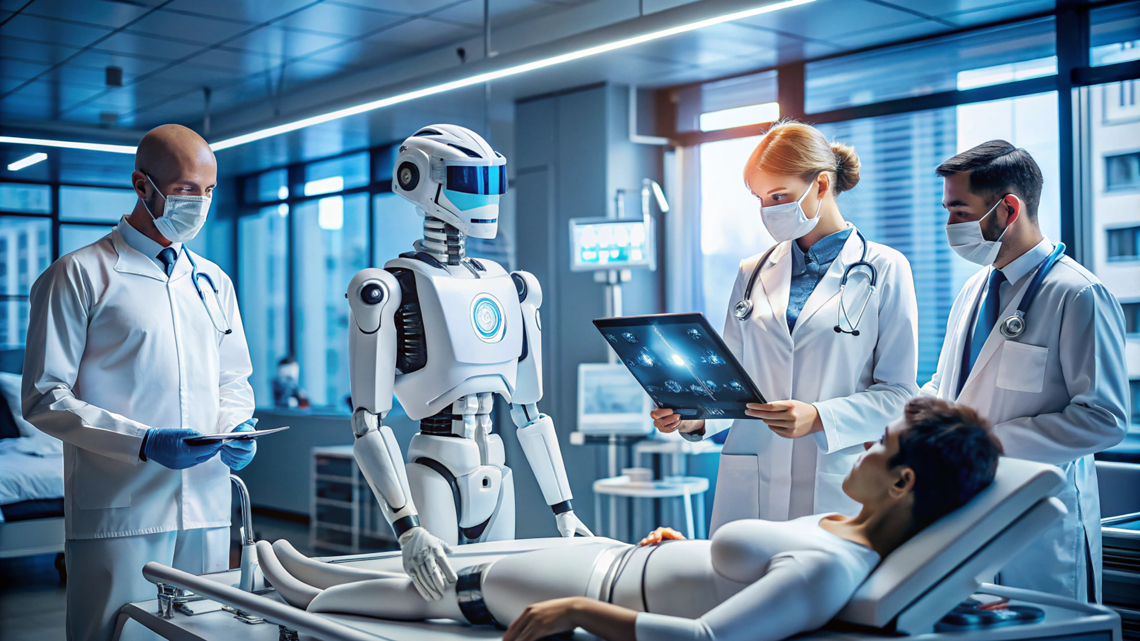
The transformation of Robotics from a futuristic concept to a reality has significantly changed the medical industry by enhanced precision diagnostic and surgical accuracy, operational efficiency and ultimately accelerating patient recovery time. Advanced Robotic technology extends beyond precision accuracy and rehabilitation but also offers automated logistic tasks, hazardous management and remote care. This blog explores the most trending medical Robots that are revolutionizing the healthcare industry with progressive innovations, allowing professionals to pivot with high level accuracy and precision.
The Impact of Medical Robotics in Healthcare
The robotics sector is redefining the medical industry with precision and accuracy. They allow performing surgeries with sub millimeters, reducing the complexities and recovery time. AS compared to human professionals, Robots outperforms due to tireless performance capacity, speed and procedure accuracy. Although Robots facilitate leading edge diagnostics and medical interventions, it cannot exhibit empathy or ethical judgment, making the human medical professionals crucial to replace.
In addition to the unwavering precision, robots can massive volumes of data sets at scale and make informed decisions, faster than human cognitive speed and analytical proficiency. Doctors might experience challenges recalling all the knowledge and information, particularly not always being aware of the latest research insights, on the other hand, Robots can make advanced choices in cross reference with up-to-date data and global research insights and vast medical knowledge. Also, Robots can be utilized to effectively handle biohazards, they thrive in extremely infectious environments and perilous conditions.
- Da Vinci Surgical System
Da Vinci Systems are a minimally invasive surgical robotics system, which enables high precision, 3D vision, and unparalleled dexterity. Da Vinci is the controlled use of multi joint surgical arms operated by a surgeon through a console. It is predominantly employed to avoid the hand tremors while humans perform surgery. It is used for mainly general surgeries, gynecology, urology, and several cardiac procedures. By translating the medical professional’s hand movements to more precise and controlled performance and management with 3D view of instruments, improves the overall procedure impact.
Benefits: Curtail pain, blood loss and scarring, and helping for a shorter recovery time for the treatment recipients.
- Cyberknife
Cyberknife systems are widely adopted in oncology, especially for radiation therapy. Cyberknife is targeting tumors by leveraging image guidance and robotic arm at an accelerated precision and accuracy. One of the main advantages of Cyberknife while compared to the traditional radiotherapy, is it can adapt and continue the procedure even when the patient moves or breathes. This adaptability with the tumor motion is making it more convenient and effective as it prevents any collateral damage.
With the help of a linear accelerator mounted to the arm, it allows tracking the real time movement of tumors from a wide range of angles, making the surgery more accurate.
Benefits: Facilitates a precise and non-invasive surgical experience for cancer patients without damaging the surrounding tissues.
- Mako SmartRobotics
These robots assist the surgeons and medical professionals for personalizing the surgical procedures and guidance prior to the operation. This is mainly adopted for joint replacement such as knee replacement or hip replacement surgeries. Mako Smart robotics in healthcare integrates a 3D CT-to evaluate patient anatomy and design procedures to improve accuracy and patient wellness. As the surgeon controls boundaries of the robotic arm, enabling painless implant placements, enhancing patient recovery days.
- PARO Therapeutic Robot
PARO is fundamentally a seal shaped interactive robot that offers emotional psychological support during generic care and mental health treatments such as Dementia. PARO is used in therapeutics to understand patient reliance, as it can simulate reactions with touch, sound and interactions, helping lower patient stress, loneliness and agitation.
- ROSA Robotic System
ROSA or Robotic Surgical Assistant systems are mainly integrated for severe and complicated neuro surgeries. These bots help medical professionals to enhance precision, safety, and accuracy performing complex neurological and spinal procedures. With this model, the surgeon uses #D imaging to completely map out the patient anatomy and robots execute operations up to sub millimeter precision. The technology is manufactured by Zimmer Biomet. The model is mainly used in Epilepsy surgery, Deep brain stimulations, biopsies, as well as spinal procedures.
- The Xenes Germ-Zapping Robot
Xenes Germ-zapping robot is a disinfection robot, mainly seen in hospital rooms and surgical suits to sanitize the area from baterias, viruses and spores. The system facilitates accelerated speed and enhanced precision, enabling after and higher grade cleaning procedures than human efficiency.
Benefits: Elevates patient safety and prevents HAIS.
- The TUG
TUG is a logistic robot, used in medical industries for offering automatic door to door deliveries including medicines, specimens and other essentials like hospital linen. The navigation is based on elevator communication and floor plan, helping to enhance operational efficiency eliminating staff’s physical burdens.
Benefits of Robotics in Healthcare
- Enhanced surgical precision and recovery due to the capacity to perform without hand tremors, providing greater dexterity, and 3D imaging for better surgical accuracy.
- Improved safety and efficiency, as it can be safely deployed for initiatives such as infection control, automated transport of medical equipment and essentials.
- Advanced diagnostics and personalized treatments due to AI driven clinical analysis, #D imaging for surgical simulations, enhanced accuracy in complex scanning procedures like MRI and CT scan without overlooking minor abnormalities.
- Increased access to care – The domain of robotics extends beyond surgical assistance. Telepresence and mobile robots support remorse care and surgical interventions.
Conclusion
Beyond imagination, the advanced inventions in medical robotics have revolutionized the way doctors perform surgeries, automated procedures and logistics, and enhanced patient recovery speed. With increased accuracy and precision with a robotic operated surgery to augment emotional and cognitive therapies, the technology is redefining the healthcare sector. Medical Robots can also be used to disinfect hospital rooms, hazardous and highly infectious areas, whereas the human operations could be comparatively risky. AR powered Robots can analyze massive volumes of real time data evidence, helping to perform surgical interventions more precisely.
To read more, visit The Healthcare Insights.
